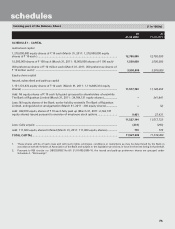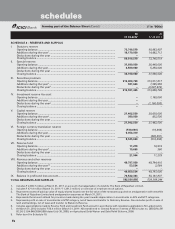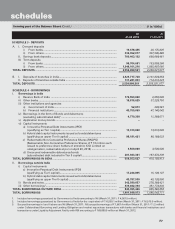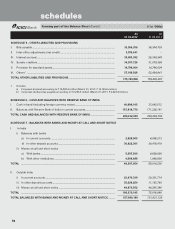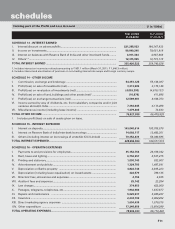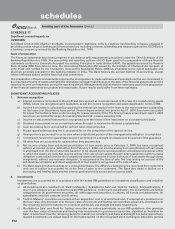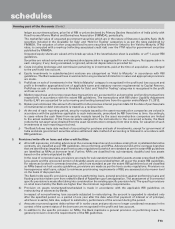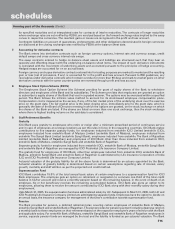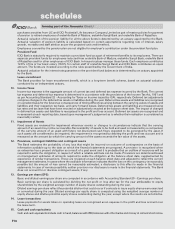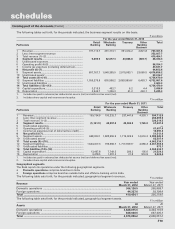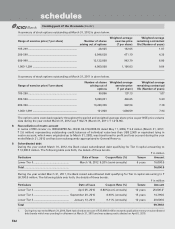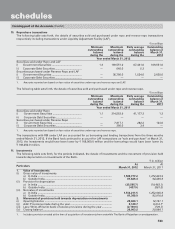ICICI Bank 2012 Annual Report Download - page 93
Download and view the complete annual report
Please find page 93 of the 2012 ICICI Bank annual report below. You can navigate through the pages in the report by either clicking on the pages listed below, or by using the keyword search tool below to find specific information within the annual report.
F15
for specified maturities and at interpolated rates for contracts of interim maturities. The contracts of longer maturities
where exchange rates are not notified by FEDAI, are revalued based on the forward exchange rates implied by the swap
curves in respective currencies. The resultant gains or losses are recognised in the profit and loss account.
Contingent liabilities on account of guarantees, endorsements and other obligations denominated in foreign currencies
are disclosed at the closing exchange rates notified by FEDAI at the balance sheet date.
7. Accounting for derivative contracts
The Bank enters into derivative contracts such as foreign currency options, interest rate and currency swaps, credit
default swaps and cross currency interest rate swaps.
The swap contracts entered to hedge on-balance sheet assets and liabilities are structured such that they bear an
opposite and offsetting impact with the underlying on-balance sheet items. The impact of such derivative instruments
is correlated with the movement of underlying assets and accounted pursuant to the principles of hedge accounting.
Hedged swaps are accounted for on an accrual basis.
Foreign currency and rupee derivative contracts entered into for trading purposes are marked to market and the resulting
gain or loss (net of provisions, if any) is accounted for in the profit and loss account. Pursuant to RBI guidelines, any
receivables under derivative contracts which remain overdue for more than 90 days and mark-to-market gains on other
derivative contracts with the same counter-parties are reversed through profit and loss account.
8. Employee Stock Option Scheme (ESOS)
The Employees Stock Option Scheme (the Scheme) provides for grant of equity shares of the Bank to wholetime
directors and employees of the Bank and its subsidiaries. The Scheme provides that employees are granted an option
to subscribe to equity shares of the Bank that vest in a graded manner. The options may be exercised within a specified
period. The Bank follows the intrinsic value method to account for its stock-based employee compensation plans.
Compensation cost is measured as the excess, if any, of the fair market price of the underlying stock over the exercise
price on the grant date. The fair market price is the latest closing price, immediately prior to the grant date, which is
generally the date of the Board of Directors meeting in which the options are granted, on the stock exchange on which
the shares of the Bank are listed. If the shares are listed on more than one stock exchange, then the stock exchange
where there is highest trading volume on the said date is considered.
9. Staff Retirement Benefits
Gratuity
ICICI Bank pays gratuity to employees who retire or resign after a minimum prescribed period of continuous service
and in case of employees at overseas locations as per the rules in force in the respective countries. ICICI Bank makes
contributions to five separate gratuity funds, for employees inducted from erstwhile ICICI Limited (erstwhile ICICI),
employees inducted from erstwhile Bank of Madura Limited (erstwhile Bank of Madura), employees inducted from
erstwhile The Sangli Bank Limited (erstwhile Sangli Bank), employees inducted from erstwhile The Bank of Rajasthan
Limited (erstwhile Bank of Rajasthan) and employees of ICICI Bank other than those inducted from erstwhile ICICI,
erstwhile Bank of Madura, erstwhile Sangli Bank and erstwhile Bank of Rajasthan.
Separate gratuity funds for employees inducted from erstwhile ICICI, erstwhile Bank of Madura, erstwhile Sangli Bank
and erstwhile Bank of Rajasthan are managed by ICICI Prudential Life Insurance Company Limited.
The gratuity fund for employees of ICICI Bank, other than employees inducted from erstwhile ICICI, erstwhile Bank of
Madura, erstwhile Sangli Bank and erstwhile Bank of Rajasthan is administered by Life Insurance Corporation of India
(LIC) and ICICI Prudential Life Insurance Company Limited.
Actuarial valuation of the gratuity liability for all the above funds is determined by an actuary appointed by the Bank.
Actuarial valuation of gratuity liability is determined based on certain assumptions regarding rate of interest, salary
growth, mortality and staff attrition as per the projected unit credit method.
Superannuation Fund
ICICI Bank contributes 15.0% of the total annual basic salary of certain employees to a superannuation fund for ICICI
Bank employees. The employee gets an option on retirement or resignation to commute one-third of the total credit
balance in his/her account and receive a monthly pension based on the remaining balance. In the event of death of an
employee, his or her beneficiary receives the remaining accumulated balance. ICICI Bank also gives an option to its
employees, allowing them to receive the amount contributed by ICICI Bank along with their monthly salary during their
employment.
Upto March 31, 2005, the superannuation fund was administered solely by LIC. Subsequent to March 31, 2005, both LIC and
ICICI Prudential Life Insurance Company Limited are administering separate funds. Employees have the option to decide on
an annual basis, the insurance company for management of that year’s contribution towards superannuation fund.
Pension
The Bank provides for pension, a deferred retirement plan covering certain employees of erstwhile Bank of Madura,
erstwhile Sangli Bank and erstwhile Bank of Rajasthan. The plan provides for pension payment including dearness relief on
a monthly basis to these employees on their retirement based on the respective employee’s years of service with the Bank
and applicable salary. For erstwhile Bank of Madura, erstwhile Sangli Bank and erstwhile Bank of Rajasthan employees in
service, separate pension funds are managed by the trust and the liability is funded as per actuarial valuation. The Bank
forming part of the Accounts (Contd.)
schedules


